Recent Storm Damage Posts
Spring Weather Hazards in Georgia | SERVPRO® of NW DeKalb / Dunwoody / Brookhaven
3/22/2022 (Permalink)
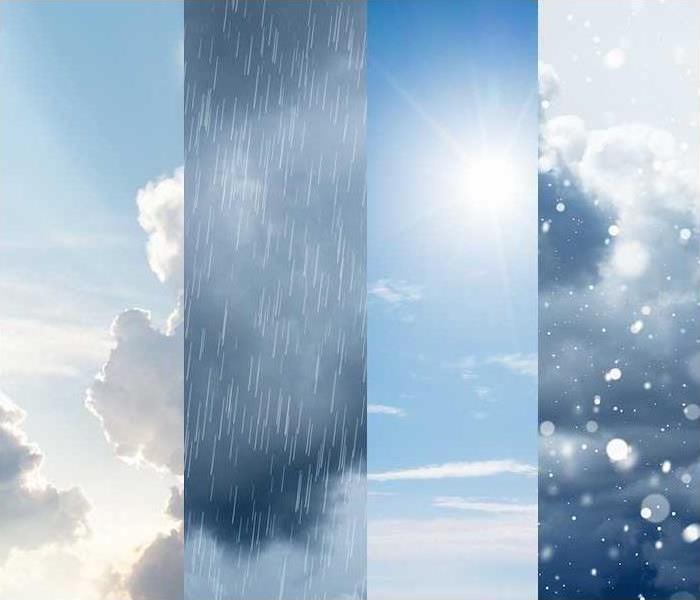 Extreme temperature changes can lead to severe weather. SERVPRO of NW Dekalb/Dunwoody/Brookhaven is a click away if you experience any damage.
Extreme temperature changes can lead to severe weather. SERVPRO of NW Dekalb/Dunwoody/Brookhaven is a click away if you experience any damage.
The United States is the world's third-largest country in terms of total land area, behind only Russia and Canada (though China is larger if all outlying US territories are excluded).
With so many distinct territories all within one country, seasonal weather is extremely diverse in the USA. As a result, each faces unique weather threats of differing degrees throughout the year.
Let's look at what to expect from some of the key areas in spring, as well as what we need to be aware of here in Georgia, when two warm and cold air masses meet throughout the country.
The Pacific Northwest is prone to significant rainfall during the spring, which can cause floods and water damage to houses. Snowfall will continue at higher elevations, and the melting and runoff from that will bring new concerns of their own.
The longest winter is in the Upper Midwest and Northeast, with temperatures sticking around for the entire season. Extreme cold and the prospect of snowstorms and blizzards may be expected from Maine to South Dakota throughout late spring or early summer, when temperatures start to rise.
On the other side, residents of the southern West Coast should be wary of intense heat waves and safety concerns, as well as possible tsunamis on Hawaii's South Pacific coast as a result of tectonic activity.
From Iowa to Texas, storms, droughts, and possible blazes will be a worry for the heartland. Wildfires can quickly spread when the wind is strong and the weather is dry. In addition, Tornado Alley lies in this region; it has a high rate of tornadoes.
Extreme weather is also a concern in the Southeast, especially in Georgia, where tornadoes and severe thunderstorms can occur in landlocked states, as well as hazardous rip currents on the coast and hurricanes during the spring. Clouds, thunderstorms, and tornadoes are common in Georgia during the spring and summer. Remnants of tropical storms that have been blowing across the sea may also trigger significant floods.
No matter where you live in the United States, weather is always a major concern. Your state might have different weather than your friend's state, but it is always a good idea to be prepared.
Help is only a phone call away if extreme weather causes you to suffer property damage from water, fire, or other agents. For prompt and professional restoration, contact SERVPRO of NW Dekalb/Dunwoody/Brookhaven.
Winter Storm Damage: Preparation, Mitigation and Renovation
2/2/2022 (Permalink)
 Adding extra insulation to attics, crawl spaces and basements is likely the best.
Adding extra insulation to attics, crawl spaces and basements is likely the best.
Winter Storm Tips
When business owners hear the phrase storm damage, they likely think of hurricanes, tornadoes or other warm climate weather, but the winter months can be just as devastating. The frigid temperatures and ice and snow storms can lead to all types of property damage, but the costliest problem is likely a burst pipe. For that reason, it is key to prepare your building and exposed pipes for the coming winter.
1. Insulation
A frozen pipe is building pressure from the inside that may eventually force a break in the seal or explode out through cracking and breaking the line. To prevent a line break, you need to keep areas where exposed pipes are located warm. This means adding extra insulation to attics, crawl spaces and basements is likely best.
2. Installation
Another excellent way to protect exposed pipes from becoming a burst pipe is to add insulation or other heating elements directly to the pipe. You can purchase pipe sleeves or even UL-listed heat tape and install it over the pipe to help prevent freezing.
3. Relocation
A more expensive approach is to relocate exposed and exterior pipes to a warmer and interior location. You will likely have to hire a professional as this job may require special permits and a level of expertise beyond your skillset.
4. Restoration
While preparation and mitigation are effective solutions, you should find and resolve current plumbing issues before they become a problem. Established leaks only make exposed pipes more vulnerable. Consistent leaking can weaken the pipe and its seal while making the pipe more prone to freezing. Check your property for standing water as one common sign of leaking, and call a disaster remediation specialist in the North Atlanta,GA, area to help you resolve the issue.
A burst pipe can be detrimental for a business, possibly causing temporary shutdown for cleanup and restoration work. To prevent freezing during a winter storm, follow the above tips, and rest assured that your business is protected through the long winter months.
How To Prevent a Mold Problem After a Flood
1/12/2022 (Permalink)
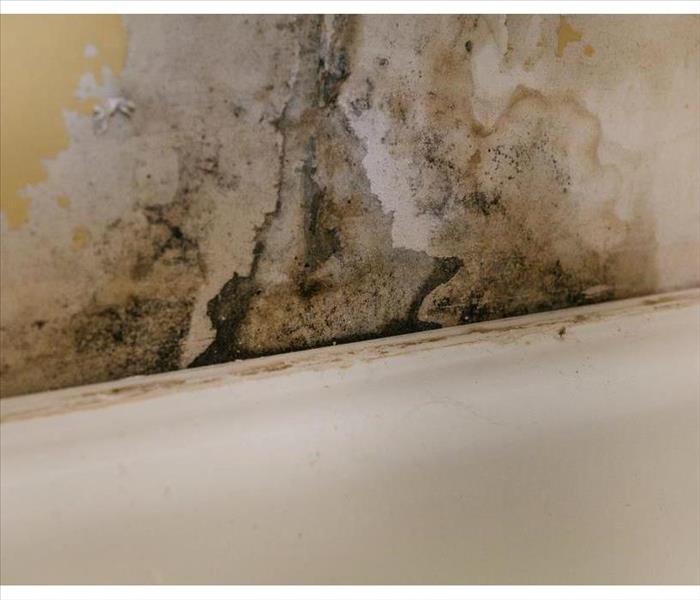 Flooding can cause many issues in your home.
Flooding can cause many issues in your home.
How to Avoid a Mold Problem Following a Flood
Flooding can cause many issues in your home. It can damage the structure of your walls, ceilings and floors. It can ruin personal items and spoil any food or toiletries it touches. If left untreated, it can also lead to mold growth. There are several things you can do to ensure that your home in Chamblee, GA, doesn't develop a mold problem in addition to water damage after a flood.
Have the Experts on Speed Dial
Your first instinct may be to call your insurance agent, but your next call should be to water mitigation experts. These professionals offer several valuable services when your home has been flooded:
- Assess extent of damage
- Create a remediation plan and timeline
- Provide an estimate of the cost of repairs
- Confirm level of damage for insurance purposes
Mold growth can occur within 24 hours of the appearance of excess moisture, particularly if it is coupled with contamination, as floodwater tends to be. Calling the experts the moment you know you need them is your strongest defense against a fungal invasion.
Get Rid of the Water
Floodwater creates a breeding ground for mold on any surface it touches. If you don't want to add mold removal to the list of expenses you incur from the flooding incident, you must remove its cause. A sump pump is useful for extracting the excess water and letting the surfaces start to dry.
Control the Humidity
Humid air can be just as inviting to mold spores as standing water. If you can safely use a dehumidifier, it can help lower the moisture in the air to discourage fungus growth. If it is not safe to plug in a machine, however, you can still increase the air flow to help dry out your home with fans and, if the air outside is not humid, open windows.
Preventing mold growth can be a challenging task, but it is possible if you act quickly. By calling in experts and reducing the moisture in your home and in the air, you can decrease your chances of secondary damage.
Develop a Business Continuity Plan in 4 Steps
11/10/2021 (Permalink)
 Conduct a business impact analysis.
Conduct a business impact analysis.
Four Steps To Develop a Plan After a Disaster
Business owners can minimize losses due to disruption after a disaster by making a business continuity plan. These four steps will help you develop a plan to keep operating after a disaster or reopen as soon as possible.
1. Conduct a Business Impact Analysis
Gather data on revenues and expenses and perform detailed assessments of the costs associated with various risks. In addition to fire, flooding, or storm damage, an impact analysis should also factor in delays or shortages of supplies or services. This analysis is also useful for determining the amount of business interruption insurance coverage needed to offset lost revenue and continued operational costs.
2. Plan Recovery Strategies
The right recovery strategies depend on the nature of a business and the level of interruption coverage. Determine whether you can operate out of a temporary location or even keep the main location open in the event of partial losses. Identify which costs or losses can be recouped through business insurance and perform a gap analysis to identify what is not covered. Strategize about how to minimize losses and quickly resume operations.
3. Implement Continuity Measures
Once you have an impact analysis, gap analysis, and strategies for recovery, you are prepared to lay the groundwork for the continuity plan. Organize a team responsible for enacting these strategies in the event of an interruption.
4. Perform Tests and Training
Put your calculations to the test as you implement these measures and train the continuity team. Update the plan with findings from testing and training.
Follow these steps to develop a continuity plan for a business in Mount Vernon, GA. Refer to a federal guide to continuity plans for further guidance. It may take anywhere from 48 to 72 hours for business interruption insurance to start. A commercial damage restoration company can help you repair damage and resume operations in a timely manner.
Keep First Aid Kits Stocked and Ready
9/14/2021 (Permalink)
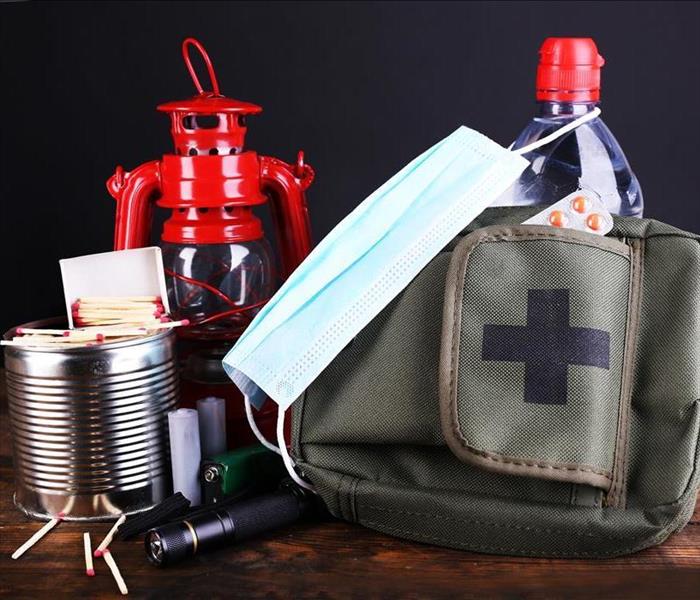 Being prepared is always key, even if the situation is unexpected.
Being prepared is always key, even if the situation is unexpected.
Steps In Creating A First Aid Kit For Your Business
If a storm wreaks havoc on your North Atlanta, GA, business, you can trust a water damage and restoration professional to get it back to normal. The first priority should always be the safety of anyone on the premises. Every business needs to have a first aid kit, and potentially more depending on the size of the company, to ensure that happens. Luckily, creating one doesn't have to be a complicated process.
What to Include
A first aid kit can be tailored to fit each unique company’s needs, especially if there are additional potential risks faced outside a normal office setting. No matter what industry, the following should be included:
- Various sizes and shapes of gauze pads, adhesive bandages, and gauze roller
- Alcohol or moistened towelettes for cleaning
- Medical tools including scissors, tweezers, adhesive tape, and disposable gloves
- A minimum of one blanket
- Resuscitation bag, airway or pocket mask
- A splint and elastic wraps
- Emergency assistance directions
How to Maintain
A business needs to be able to rely on an emergency kit at a moment’s notice, so it is important to establish a person to be in charge of maintaining kits. A checklist should be created to keep tabs on the established number and type of item to help ensure it remains stocked. An inspection should be done regularly to verify that it will be ready when needed.
When doing an inspection, it is also important to not just count what is there. Some items could be damaged or expired. Keeping track of frequently used items is also important. It can help you better plan what to stock, as well as determine if a smaller everyday kit needs to be available and easily accessible.
Being prepared is always key, even if the situation is unexpected. Maintaining a fully stocked first aid kit is one way to ensure employee and customer safety.
Listen to Dave Matthews and Don’t Drink the Water: What You Need to Know about Black Water
9/2/2021 (Permalink)
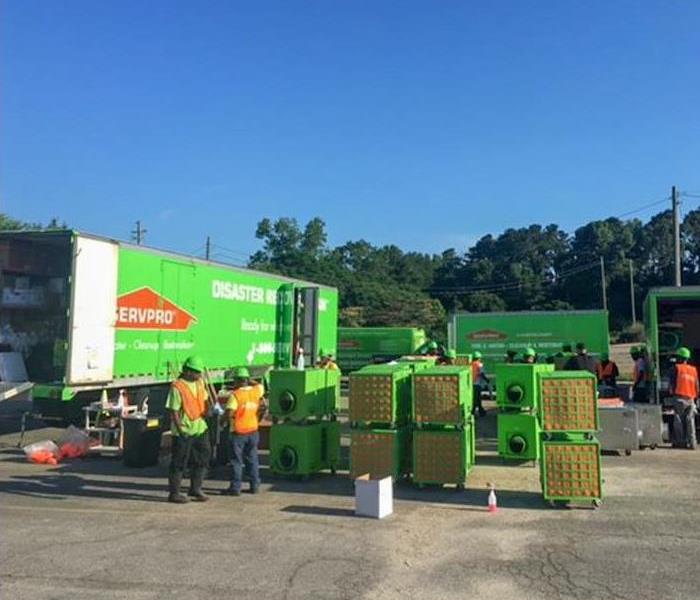 Blackwater damage at any level is dangerous. The mixture of sewage and other contaminants provides a significant health risk, and it should be avoided
Blackwater damage at any level is dangerous. The mixture of sewage and other contaminants provides a significant health risk, and it should be avoided
A flood can cause significant damage, but the most significant risk comes from standing water, especially when that water is considered black water. This type of water is created from above-ground flooding and sewage backups, and it is considered contaminated and toxic to people and animals, causing both severe illness and even death. That being said, there are three levels of black water damage, each with varying degrees of severity.
1. Level I
At Level One, this type of contamination is limited to a single structure, and it typically affects a small area. Additionally, this type of water contamination is realized and resolved quickly. A restroom with an overflowing toilet is an example because the situations are usually fixed quickly, not allowing time for the water to penetrate the structure or other porous materials.
2. Level II
At level II, the damage is more significant than Level I because the exposure time and contaminated area are more significant. In this instance, there will likely be a need to remove any items, porous or nonporous, that touched the contaminated water, including furniture, drywall, carpeting, fabrics, and cabinets.
3. Level III
At level III, the water damage is extensive and was brought on by outside sources like city mains and septic systems and is further exacerbated by storm surges and the rising of rivers and streams. Level III usually has a longer incubation time, meaning that the water is filled with a mix of mold, viruses, bacteria, and sewage.
While saving money is tempting, cleaning up from a flood yourself is not always advisable as the water is now a dangerous substance. Check with the North Atlanta, GA, municipality, or your insurance provider for suggestions of local restoration specialists.
Blackwater damage at any level is dangerous. The mixture of sewage and other contaminants provides a significant health risk, and it should be avoided at all costs.
How Can You Prepare Your Business for a Snowstorm?
6/14/2021 (Permalink)
 Check the weather forecast every few days.
Check the weather forecast every few days.
Winter storms are not unusual in Dunwoody, GA. Owning a business in this region means being ready for a big punch. However, if you’re prepared for the weather, a snow storm can be nothing more than a passing inconvenience.
How Can You Know One Is Coming?
Weather is a hot topic these days. While there’s still a lot of guesswork in forecasting, modern science has helped their accuracy enormously. Big storms are typically predicted days before they strike, and this is disseminated through many channels, including
NWS radio
NWS Website
Emergency phone alerts
Radio
Television
Many NWS local stations also post weather information to social media. If you’ve heard talk about a coming storm, make sure to check one of these sources. Also, check the long-term forecast every few days. If a storm is predicted, pay close attention and get ready if you aren’t already.
How Can You Be Ready When a Snow Storm Hits?
Winter storms are one of the costliest disasters to hit the U.S. They can blanket an entire region with feet of snow and often paralyze cities. A business may choose to shut down when a large storm is approaching. If so, you should shut off utilities and depressurize your plumbing to avoid a pipe burst if any of it is susceptible to cold weather.
Large snowstorms often ride on a front boundary that tends to be close to freezing. However, once the storm passes, extremely cold air often follows, meaning that exposed plumbing must be prepared for it.
What Should You Do If Your Business Is Damaged?
Commercial storm damage needs to be inspected immediately by a winter weather restoration expert. If it has left areas exposed to the elements, your building will need to be tarped and boarded. Heavy snow can damage roofs and ice jams can cause mass destruction. Call as soon as possible because, in a large storm, they’re likely to get pretty busy.
It’s up to you to ensure your business is ready for a snow storm. Discuss your plans with key employees and consider all the likely contingencies.
Mitigation and Restoration Are Essential Stages of Water Damage Cleanup
3/30/2021 (Permalink)
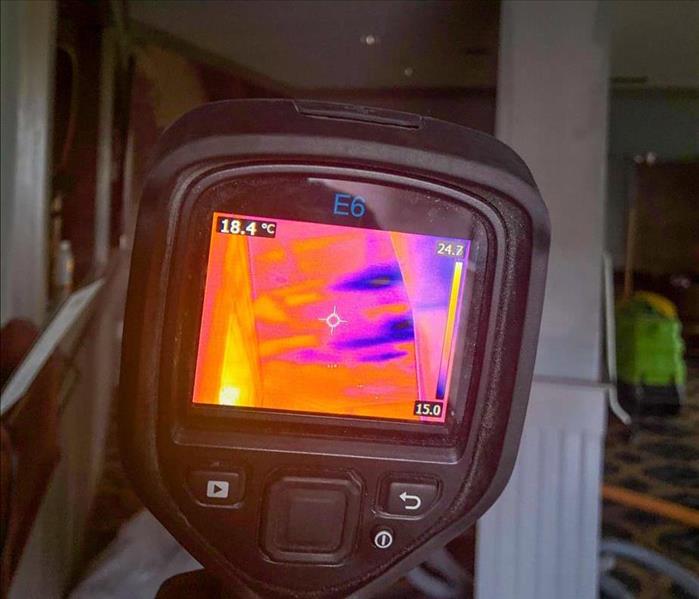 Assessing the area with a thermal imaging camera.
Assessing the area with a thermal imaging camera.
When a flood cleanup company examines a water-logged facility, the team should discuss two cleanup stages: mitigation and restoration. What are they different, and why are both vital to repair? It's probably tempting to dry everything out move on, but the specialists should explain that in cases of water damage, that effort isn't enough. Owners must consider both phases because prevention and rebuilding are vital to securing the area. Collaborate to establish a plan of action that gets your operations back up and running without concerns of future issues like mold growth.
What Happens During Mitigation?
When the storm ends, and the water recedes, a restoration company should immediately attend to the property. The fluid from rain and floods permeates into porous materials. This lingering moisture, if not appropriately treated, permits mold, mildew and bacteria to develop. Rot and structural integrity could also become issues as wood and ceilings. The goal of mitigation is to reduce the likelihood of these secondary conditions.
A flood cleanup company in Brookhaven, GA works with certified environmental specialists to assess the premises, testing to determine where contamination exists and how to treat it best. Within hours, the crew begins drying efforts. The workers should complete the following actions:
- Pull up saturated carpet
- Remove damp objects for content cleaning
- Toss soiled valuables
- Run industrial dehumidifiers
- Perform necessary flood cuts
Once the room is dry, the team scrubs the walls and sanitizes with antimicrobial spray.
How Is Restoration Different?
While the early efforts focus on minimizing further concerns, the restoration company concentrates on mending the physical structure. This part of the project is slower. In remediation, crew members accomplish tasks at the same time. During the restoration, workers rebuild. Often, workers complete one thing before moving on to the next. Staff members replace anything pulled out, patch the walls and add a coat of paint. They also return any valuables that they salvaged.
A flood cleanup company understands that preventative measures are necessary. Their efforts with mitigation save owners future hassles. It's tempting to want to dry and paint, but taking time to care for the space is vital.
3 Reasons You Should Not Drive Through Flooded Streets
1/15/2021 (Permalink)
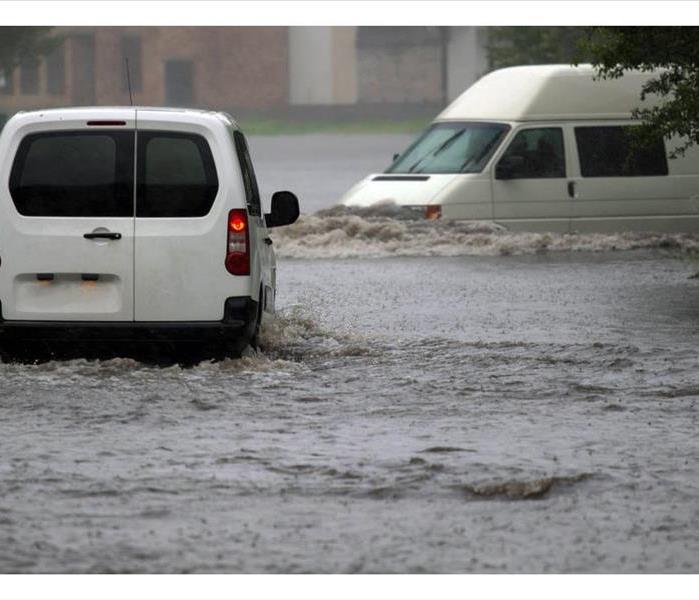 Driving on a flooded street puts you and your passenger at risk
Driving on a flooded street puts you and your passenger at risk
Three of the Reasons You Should Not Attempt To Drive Through Floodwaters
One of the most common risks associated with flash flooding is drivers attempting to drive through water on a flooded street.
1. You Don't Know What Is Under the Water
Flooded roads may have debris, depressions or areas that have been washed away that you can not see because they are covered by water. Attempting to drive through what may appear to be shallow water could lead to a collision with an object under the water, losing traction and sliding off a washed-out road, or driving into water that is much deeper than it appears.
2. The Water Can Damage Your Car
Another reason not to drive down a flooded street is that the water can damage your car. Water that is six inches deep can flood the exhaust of your vehicle and cause it to stall. The water may also damage the engine, transmission, cooling and electrical systems of the vehicle. If the water is deep enough, it may cause interior damage to the floorboards, seats and other surfaces that will need to be professionally cleaned to avoid mold growth and other problems.
3. You Could Drown
About half of all flood-related drowning deaths occur because of drivers attempting to drive through floodwaters. Six inches of water can cause your vehicle to lose traction with the road. 12 inches of water will cause most cars to float. Large trucks and SUVs will float in two feet of water. Passengers in a car that gets swept off the road by floodwaters are at a high risk of drowning, which is why travel tips for Brookhaven, GA advise drivers to turn around instead of driving through floodwaters.
Attempting to drive down a flooded street puts you, your passengers and your vehicle at risk. For these three reasons, do not attempt to drive through floodwaters.
Does My Storm Damage Qualify For a Tax Deduction?
11/11/2020 (Permalink)
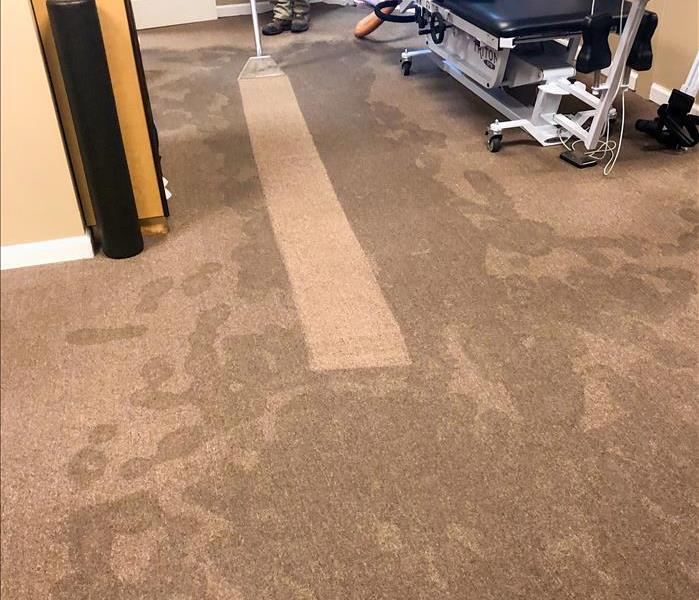 If you think your storm damage is tax-deductible, be sure to have proper documentation to back up your claims and calculations
If you think your storm damage is tax-deductible, be sure to have proper documentation to back up your claims and calculations
Use This Four-Step Checklist To See If Your Damage Is Likely To Be Tax-Deductible.
If you experience storm damage to your business property or other commercial building, you may be able to deduct some of your losses on your income tax return.
1. Did the Storm Cause Damage to Your Business Property?
Property damage caused by a storm or other disaster is considered a “casualty loss” under Section 165 of the Internal Revenue Code. For commercial property, you can deduct an amount equal to the reduction in the property’s market value as a result of the damage; in other words, the property’s value right before the storm, minus its value right after the storm.
Most people don’t have appraisal figures for right before and right after a storm. Instead, the IRS allows taxpayers to add up the total cost of repairs and storm restoration expenses to calculate the deduction amount.
2. Was the Damage Covered By Insurance?
Insurance coverage is not a requirement for deducting casualty losses; however, if your property was covered by insurance when the storm hit, you must have filed an insurance claim for the storm damage to be considered deductible. You must subtract any insurance payments you received for the damage from your claimed deduction amount.
3. Was the Property Within a Federal Disaster Area?
If the damaged property was within a federally declared disaster area at the time of the loss, there may be additional deductions available. Check FEMA’s website to see disaster information for Brookhaven, GA.
4. What About Other Losses?
Some additional storm-related losses, like destroyed inventory, may be deductible as business expenses under Section 162. Some expenses which are not tax-deductible include
- intangible losses, such as lost income
repair costs for damage caused by ordinary - wear and tear
- losses due to looting or theft
If you think your storm damage is tax-deductible, be sure to have proper documentation to back up your claims and calculations. If you’re unsure, it’s best to consult a tax professional.
No Flood Insurance? Here's How To Get Help
10/20/2020 (Permalink)
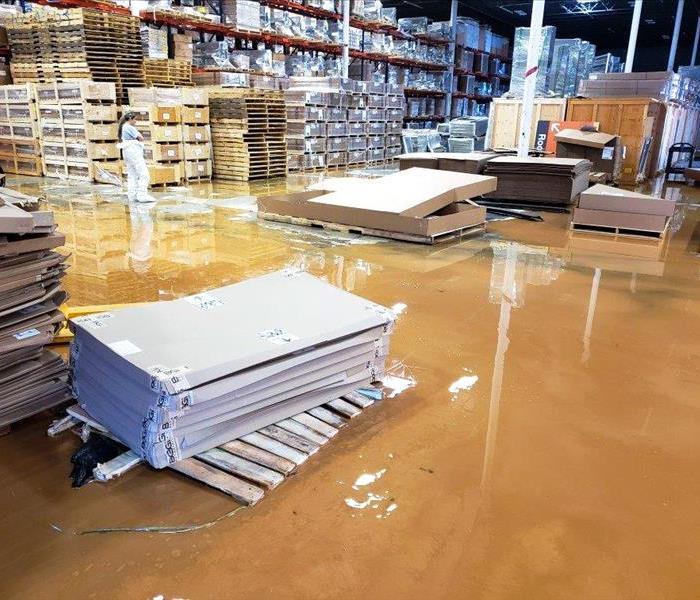 Flooded warehouse in Dunwoody, GA
Flooded warehouse in Dunwoody, GA
The best way to protect your household if a flood event occurs in Dunwoody, GA is to purchase flood insurance. However, if you have flood damage and no insurance coverage, some relief options are still available.
Disaster Loan From the Small Business Administration
The Small Business Administration, or SBA, provides low-interest loans to assist in recovery from a declared disaster for the following people:
- Homeowners
- Renters
- Business owners
You don’t need to be a business owner to apply for a disaster loan from the SBA. You will need to prove that the flood damage is not covered by insurance. Maximum interest rates range between 4% and 8%, depending on your eligibility for credit elsewhere. You’ll need to complete and return a loan application. If the SBA determines you are not eligible for a loan, you’ll automatically be referred to the Federal Emergency Management Agency's Individuals and Households Program.
FEMA Individuals and Households Program
The FEMA IHP provides both financial and direct services to individuals and households who have uninsured or underinsured expenses and serious needs. Those who receive a grant and do not have flood insurance will not have to pay it back. If you have insurance, you are required to pay back the grant but may use the insurance money to do so.
IHP assistance may be used for temporary housing such as rental assistance or hotel expenses, funds to replace, repair, or provide storm damage restoration services of primary residences to make the home safe to live in, and other serious needs such as moving and storage, medical care, and child care.
Private Insurance
If you’re concerned about a future flood event or live in a flood plain, private insurance often has a short waiting period of 10-14 days. However, you cannot purchase insurance to cover an event that has already happened. If you have previously had flood and water damage to your residence, seriously consider purchasing insurance to protect you in the future.
The best time to consider disaster services is before a flood event occurs, however, if you don’t have flood insurance, other options are available to you.
The ABCs of Flood Insurance
8/7/2020 (Permalink)
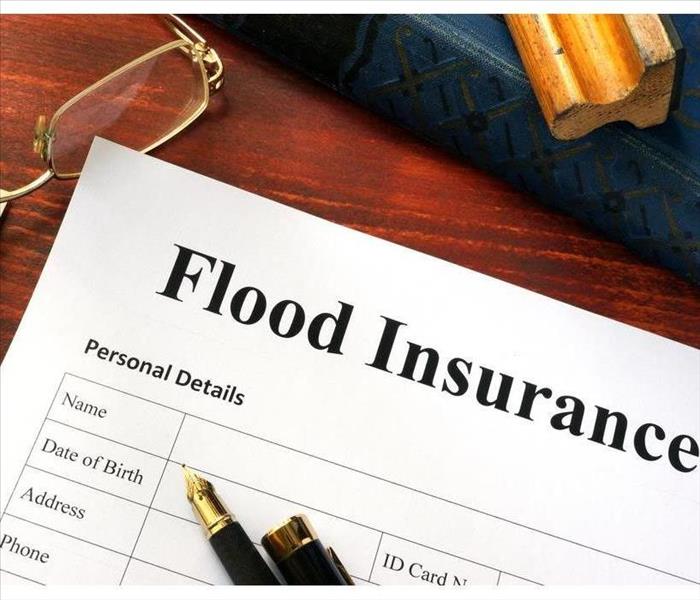 If you do not have flood insurance, other programs may be able to provide financial assistance to you
If you do not have flood insurance, other programs may be able to provide financial assistance to you
If your home in Chamblee, GA, is hit by a flood, it's good to know that you are not alone. A number of agencies and companies can help you in a time of unprecedented disaster. Immediately following a flood, you may need help with rescue or medical assistance. First responders, EMTs, and other professionals answer the call to make sure those suffering are taken care of. The next step is to see if you have insurance coverage. This is usually offered by the federal government under the National Flood Insurance Program.
This program, administered by FEMA, is only available in certain communities, typically those located on a flood plain. The goal of the NFIP is to reduce the impact of floods on private and public structures.
What To Do If You Have Insurance for Flooding
You should follow certain steps if you have this insurance. Understanding how the process works can help you cope with this difficult situation. Follow these steps to get the claims process rolling:
- Contact your insurance agent or adjuster to report your flood loss
- Document the damage to your home when it is safe to do so
- Work closely with your insurance company
- Receive your payment
If you do not have flood insurance, other programs may be able to provide financial assistance to you. Loans and grants are often available to homeowners and renters hit hard by flooding.
Who Else To Contact After a Flood
Flooding causes serious damage to a home. It also raises a number of safety issues. Calling in a local storm remediation company is an important step in your recovery. Workers with expertise and experience can arrive quickly and determine the best course of action. They can secure the home for safety, remove the water, and begin to work on cleaning and restoring the home to its original condition. An experienced company can also help document the damage for your flood insurance claim.
 Extreme temperature changes can lead to severe weather. SERVPRO of NW Dekalb/Dunwoody/Brookhaven is a click away if you experience any damage.
Extreme temperature changes can lead to severe weather. SERVPRO of NW Dekalb/Dunwoody/Brookhaven is a click away if you experience any damage.





 24/7 Emergency Service
24/7 Emergency Service









